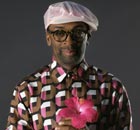 Lee lays it down for the Guardian
Lee lays it down for the Guardian
Ever since a college project filming riots in New York in 1977, Spike Lee has used his movies to provide an alternative commentary on life in his home country. Here, he tells John Colapinto what the future holds now that Obama has torn up the script for African-Americans
One morning last June, Spike Lee arrived early at the Sony Pictures Studios, in Culver City, California, to record the score for his new feature, Miracle at St Anna, a second world war film about the US Army’s 92nd Division, an all-black unit that battled the Nazis during the Italian campaign. Lee was joined in the studio’s control room by his music-recording team. A large window overlooked the cavernous soundstage where Judy Garland recorded “Over the Rainbow”, in 1938, when the lot belonged to MGM. A 95-piece orchestra that Lee had engaged had not yet arrived.
A month earlier, at a press conference at the Cannes Film Festival, Lee had sparked a very public feud with Clint Eastwood when he accused him of having omitted black soldiers from his two recent movies about Iwo Jima, Flags of Our Fathers and Letters from Iwo Jima. (Historians estimate that between 700 and 900 black servicemen participated in the battle.) The spat had escalated quickly. Eastwood told the Guardian that he had left out the black soldiers because none had actually raised the flag, adding that “a guy like that should shut his face”. Lee shot back, telling ABCNews.com, “The man is not my father and we’re not on a plantation either.”
Lee’s remarks appeared online three days before he began recording the score for Miracle at St Anna. Lee sees the movie, the first by a major American director to treat the experience of black soldiers in the war, as redress not only for Eastwood’s pictures but for an all-white Hollywood vision of the second world war which dates to the 1962 John Wayne movie The Longest Day – and before.
As the orchestra began to gather on the soundstage, Lee scribbled notes about the score on a yellow legal pad. He is 5ft 6in, with a barrel chest and a pigeon-toed walk. His baleful, half-hooded eyes peered out from behind tortoiseshell frames. There was a diamond stud in his left earlobe. He is 51, has a small bald spot at the crown of his short Afro, and wore an orange T-shirt with a picture of Barack Obama and the word “REPRESENT”.
It’s been more than 20 years since Lee’s debut, the 1986 movie She’s Gotta Have It – a breezy sex comedy about a liberated African-American woman and her three male suitors – and he remains Hollywood’s most prominent black filmmaker. He has directed 18 features, three of which (Do the Right Thing, Jungle Fever, and Malcolm X) have earnt him a reputation as a filmmaker obsessed with race. Releasing movies at an average of nearly one a year, Lee has maintained a pace matched only by Woody Allen.
Lee is the artistic director of NYU’s graduate film programme, where he teaches a master class in directing. He also makes music videos and TV ads (he has done spots for Converse, Jaguar, Taco Bell and Ben & Jerry’s, among others) and has made two superb documentaries: 4 Little Girls, about the 1963 bombing by the Ku Klux Klan of a black church in Alabama, and When the Levees Broke, about the aftermath of Hurricane Katrina. He is able to accomplish so much in part because he often rises at 5am. “You want to get a lot done, you gotta get up in the morning,” he told me. The rest, he says, is “time management”. But Lee’s output also reflects the unusual fecundity of his imagination. “Spike was the idea man,” Herb Eichelberger, who taught Lee in an undergraduate film course in Atlanta in 1977, told me. “He was a good writer, and he would explore those ideas and turn them into full-blown mini-epics.”
Leave a Reply